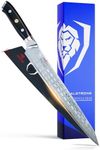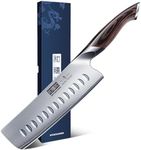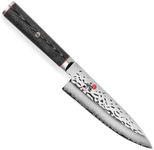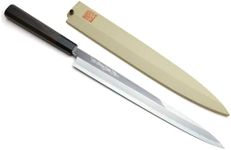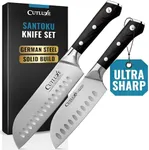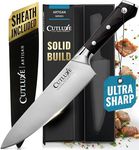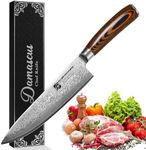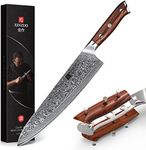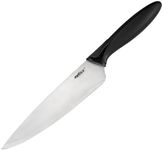Buying Guide for the Best Sushi Knives
Choosing the right sushi knife is essential for anyone who wants to prepare sushi with precision and ease. Sushi knives are specifically designed to handle the delicate nature of sushi ingredients, ensuring clean cuts and preserving the texture and flavor of the fish and other components. When selecting a sushi knife, it's important to consider several key specifications to find the best fit for your needs. Understanding these specs will help you make an informed decision and enhance your sushi-making experience.Blade MaterialThe blade material of a sushi knife is crucial as it affects the knife's sharpness, durability, and ease of maintenance. Common materials include stainless steel, high-carbon steel, and Damascus steel. Stainless steel is resistant to rust and easy to maintain, making it a good choice for beginners. High-carbon steel is extremely sharp and holds its edge well but requires more care to prevent rust. Damascus steel combines the benefits of both, offering sharpness, durability, and a beautiful pattern. Choose stainless steel if you prefer low maintenance, high-carbon steel for superior sharpness, or Damascus steel for a balance of both.
Blade LengthThe length of the blade determines how easily you can slice through different types of sushi ingredients. Sushi knives typically range from 8 to 12 inches. Shorter blades (8-9 inches) are easier to control and are suitable for smaller fish and vegetables. Medium blades (10-11 inches) offer a good balance between control and versatility, making them ideal for most home cooks. Longer blades (12 inches) are preferred by professionals for slicing larger fish and making long, clean cuts. Choose a blade length based on the size of the ingredients you usually work with and your comfort level with handling the knife.
Blade ShapeThe shape of the blade affects how the knife performs different tasks. The most common shapes for sushi knives are Yanagiba, Deba, and Usuba. Yanagiba knives have a long, thin blade ideal for slicing raw fish with precision. Deba knives are thicker and heavier, designed for cutting through fish bones and filleting. Usuba knives have a flat edge, perfect for cutting vegetables with precision. If you primarily slice fish, a Yanagiba is the best choice. For filleting and cutting through bones, opt for a Deba. If you focus on vegetable preparation, an Usuba will serve you well.
Handle MaterialThe handle material of a sushi knife affects comfort, grip, and durability. Common materials include wood, plastic, and composite. Wooden handles offer a traditional look and feel, providing a comfortable grip but requiring more maintenance to prevent damage from moisture. Plastic handles are durable, easy to clean, and resistant to moisture, making them a practical choice for everyday use. Composite handles combine the benefits of both, offering durability and a comfortable grip. Choose a handle material based on your preference for maintenance and the level of comfort you desire during use.
Single-Bevel vs. Double-BevelSushi knives can have either a single-bevel or double-bevel edge. Single-bevel knives are sharpened on one side only, allowing for extremely precise cuts and are traditionally used in Japanese cuisine. They require more skill to use and maintain but offer superior performance for tasks like slicing fish. Double-bevel knives are sharpened on both sides, making them easier to use and maintain, and are more versatile for various kitchen tasks. If you are a beginner or prefer a more versatile knife, a double-bevel edge is a good choice. For experienced users looking for precision, a single-bevel edge is ideal.

